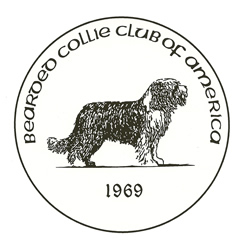(September 2022)
“With or without white markings,” the Beardie standard states. When was the last time you saw a Beardie without white markings? Way back in the 1950 through the 1970 years, there were a few around. Quite possibly dog shows played a part in their eventual disappearance. Today, plain, unmarked Beardies are as rare as snowflakes in Florida. Let’s face it, white markings are flashy. As long as they conform to the accepted placements according to the standard, they may be subtle or splashy. Predominantly white Beardies also exist and are not disqualified but are frowned upon as mismarks. The white beard, muzzle, collar, chest, paws and tip of tail provide a striking contrast to the basic body color. They add to the expression, delineate the length of neck, show off the breadth of chest as well as make it easier to assess gait with the gleaming paws in action. There’s really only one major drawback to white markings. They don’t stay that way!
Keeping them white is the catch. Sometimes it’s a matter of environment. A Beardie who doesn’t have the opportunity to wade in mud puddles, excavate subway systems in the yard or romp in a swamp is going to stay cleaner than those who do. Sometimes it’s just the nature of the beast. A few Beardies can be downright fastidious. Bounce, one of my early Beardies, wouldn’t even leave the front porch to relieve herself if it was raining. Once at an outdoor obedience trial in the rain, she got around the problem of sitting on the disgusting, soggy ground by parking her rear on my foot whenever the judge called “halt.” On the other hand, there are dogs like Pigpen in the Peanuts cartoon who can get dirty in a snowstorm.
It’s not just the paws. While those are the most likely to collect unwanted coloration, the beard is another culprit. Saliva stains are the most common problem. Here’s a hint. Don’t feed your dog spaghetti sauce. That’s one of the foods which can leave stains in the beard. There are numerous others.
The rest of the white markings are relatively safe from color contamination thanks to their placements. Though now that I think of it, one of the gang stretched out on a wet rug and ended up with a blue chest. The first line of defense against stained whites is not to let them occur in the first place. Beardie booties are a great invention to keep paws clean. Lacking this footwear, it’s possible to slip socks or plastic bags over paws when the going gets messy. As for the beard, cleaning it nightly with waterless shampoo is a good idea. An alternative is to brush corn starch into the beard each evening or as needed.
Now we come to the heart of the matter, which is how to return stained white markings to pristine, glowing white. Almost every line of grooming supplies includes a whitener shampoo. Some are more efficient than others. But what happens when the whitener shampoo just can’t cut it? In the show ring, exhibitors are looking for every advantage. Just white won’t do when there’s the possibility of shining, glimmering, shimmering white with the right product. One of the Beardie groups on the internet asked readers what they used when faced with stubborn stains. One exhibitor wrote of first using a waterless shampoo and while the legs were still damp, brushing in Faultless Blued Dry Starch, then brushing it out before ring time. A handler suggested loading up the damp beard and paws with baby powder and allowing it to dry before brushing. A prominent breeder told of putting diluted Calgon on the legs about 10 minutes prior to bath time. Two other breeders recommended using Tide Free on the legs and face. They opted for this approach after reading in Consumer Reports that Tide was top of the crop in stain removal, and while it didn’t completely remove the stains, it was said to reduce them by half. Next, the aforementioned corn starch works as well on paws as on beards with the added advantage of drying damp white paws.
Finally, a pharmacist came up with the idea of combining equal parts Clairol Crème Developer and Milk of Magnesia. Applied to the coat, it should be left to dry before brushing out. Please remember that some of these concoctions may dry out the coat and make it porous, meaning it may be more likely to soak up dirt and stains in the future. A crème rinse or conditioner after any such treatment can help counteract this.
So far, there’s been only a brief mention made here about bluing and its various uses. It’s known to take the yellowish tint from white hair, but use it carefully. A Samoyed breeder elected to remove urine stains from her dog’s legs with bluing. In this case, blue plus yellow equaled green, not an accepted color for show ring Sams, she found to her dismay. Also, in my childhood, a few centuries ago, I had a crossbreed who was part Rough Collie and part Eskimo Spitz, as they were known in those days. Today they’re called American Eskimo dogs. She was primarily white with brown around her eyes and ears. My grandmother decided she could be whiter and turned to the bluing she used to get rid of the yellow out of her gray hair. I believe she calculated how much she used on her own hair and tripled it. As it turned out, my dog was a lovely shade of blue. So take warning and use bluing with care if you must.
When you consider what it takes to keep those markings white, maybe breeders shouldn’t have been in such a hurry to get rid of the unmarked Beardies.
— alice bixler, Bearded Collie Club of America. Email Alice




